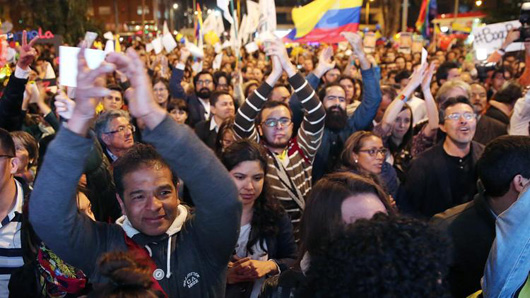
Ivan Márquez, head of the negotiating team of the Revolutionary Armed Forces of Colombia – People’s Army (FARC-EP) tweeted from Havana late on August 24: “White smoke leaves from the conclave in Havana; Habemus Pacem (We have peace).” He and his counterpart Humberto de la Calle, the lead negotiator for the Colombian government, had just signed a peace agreement ending 50 years of armed conflict.
The accord, described by labor leader and political prisoner Hubert Ballesteros as “the most important achievement on the American continent in years,” capped four years of negotiations in the Cuban capital. The signing ceremony and the release of “Joint Communique # 93,” which summarized the “final, comprehensive, and definitive agreement,” took place in the presence of Cuban Foreign Minister Bruno Rodriguez and representatives of the guarantor countries, Cuba and Norway.
Shortly thereafter Colombian President Juan Manuel Santos announced that a national plebiscite for endorsing the agreement, approved by Colombia’s Constitutional Court on July 15, will take place October 2. (The FARC-EP had previously called for a constituent assembly to do the endorsing.)
The agreement signed on August 24 represents final approval of preliminary agreements reached on six specific points of an agenda established before the formal talks began. They were:
“Comprehensive rural reform,” “Political participation,” “An end to shooting and hostilities; giving up arms,” “Solution to the problem of illegal drugs,” Victims,” and, lastly, “Mechanisms of implementation and verification.” The third of these also provides the guerrillas with guarantees against paramilitary assaults.
The Joint Communiqué claimed implementation of the accords would help alleviate adverse effects of the war and, in line with FARC-EP expectations, address the “historic causes of the conflict.”
The document praised citizen participation as crucial to reaching the agreements that, together, led to the final accord. They dealt with women’s rights, “vulnerable social groups,” small farmers, displaced persons, and LGBTI people.
Negotiators had spent 18 difficult months before being able on December 15, 2015 to celebrate their agreement on the “victims” issue. That they had successfully dealt with reparations, amnesty, and punishment of combatants accused of crimes made it clear that a final agreement would eventually materialize.
There was fanfare also on June 23 when the negotiators announced agreement on their last agenda covering a ceasefire, giving up arms, and mechanisms for verification. On August 5 the two parties released protocols governing the process of disarming and verification, and also protecting civilians and monitoring personnel in the 23 zones where the former guerrillas would give up arms. Guidelines were issued covering the role of United Nations monitoring officials.
Controversy lingered over methods for choosing judges for the Special Peace Tribunal that, established under the agreement on “Victims,” would determine the fate of combatants accused of crimes. Then on August 12 negotiators announced plans for a high-level international committee to select them.
Observes unite is saying that the work of bringing peace to Colombia has barely begun. The campaign for a Yes vote in the plebiscite is gathering stream as the FARC -EP and supporters take their “pedagogy for peace” campaign to the Colombian people.
In his remarks August 24, Ivan Márquez indicated, “We may be able to proclaim that war with arms is ending and debate over ideas is beginning … The peace agreement is no point of arrival but is a point of departure so that a multi-ethnic and multicultural people, united under the flag of inclusion, may be the smithy and sculptor of the change and social transformation that most people are crying out for.” He envisions the agreement as leading to a constituent assembly.
There’s major unfinished business. The other insurgency, the National Liberation Army (ELN), smaller than the FARC-EP, is still at war with the state. Simon Trinidad, FARC-EP leader and member of the insurgency’s negotiating team, is still lodged in a super-max U.S. federal prison, despite calls for his release. Some 9500 political prisoners – opposition activists and prisoners of war – still languish in Colombian prisons. Paramilitary death squads still roam the country and “nearly 250 municipalities … are at risk of violence or fraud affecting the referendum” on the peace agreement.
Nevertheless, an end to war is a monumental advance, especially in view of its toll on human survival and wellbeing. A congratulatory salute to the peace negotiators from the Colombia Support Network summarizes: “1906 villages destroyed by massacres; 7 million displaced peasants; 280,000 civilians killed by all the armed actors together; the political genocide against the Union Patriotica Party formed by the FARC after a previous peace agreement; the suffering of the kidnapped victims; the “false disappeared” -civilians killed purposely by the Colombian Army in order to increase their body count; the more than 45,000 disappeared due to the conflict; the thousands of women raped and humiliated.”
Photo: People react as they watch the live broadcast from Havana of the peace agreement signing ceremony between the Government of Colombia and the Revolutionary Armed Forces of Colombia (FARC), in Bogota, Colombia, 24 August 2016. | aboutcroatia.net







